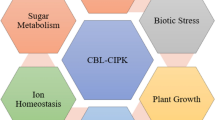Abstract
Much is now known about proline multifunctionality and metabolism; some aspects of its biological functions are still unclear. Here, we discuss some cases in the proline, structure, definition, metabolism, compartmentalization, accumulation, plausible functions and also its implication in homeostasis and organism physiology. Indeed, we report the role of proline in cellular homeostasis, including redox balance and energy status and their implication as biocatalyst for aldolase activity. Proline can act as a signaling molecule to modulate mitochondrial functions, influence cell proliferation or cell death, and trigger specific gene expression, which can be essential for plant recovery from stresses. Although, the regulation and the function of proline accumulation, during abiotic stresses, are not yet completely understood. The engineering of proline metabolism could lead to new opportunities to improve plant tolerance against environmental stresses. This atypical amino acid has a potential role in the toxicity during growth of some microorganism, vegetal, and mammalian species. Furthermore, we note that the purpose through the work is to provide a rich, concise, and mostly cohesive source on proline, considered as a platform and an anchor between several disciplines and biological functions.

Similar content being viewed by others
References
Michael, L. (1981). Effect of proline residues on protein folding. Journal of Molecular Biology, 145, 251–263.
Grathwohl, C., & Wüthrich, K. (1976). The X-pro peptide bond as an nmr probe for conformational studies of flexible linear peptides. Biopolymers, 15(10), 2025–2041.
Saibi, W., Drira, M., Yacoubi, I., Feki, K., & Brini, F. (2015). Empiric, structural and in silico findings give birth to plausible explanations for the multifunctionality of the wheat dehydrin (DHN-5). Acta Physiologiae Plantarum, 37(3), 1–8.
Szabados, L., & Savouré, A. (2010). Proline: a multifunctional amino acid. Trends in Plant Science, 15(2), 89–97.
Shi, M, Hao, S, Chan, T, & Xiang, J. (2006). CD4+ T cells stimulate memory CD8+ T cell expansion via acquired pMHC I complexes and costimulatory molecules, and IL-2 secretion. Journal of Leukocyte Biology 80: 1354–1363
Prasad, U., bin Jalaludin, M. A., Rajadurai, P., Pizza, G., De Vinci, C., Viza, D., & Levine, P. H. (1996). Transfer factor with anti-EBV activity as an adjuvant therapy for nasopharyngeal carcinoma: a pilot study. Biotherapy, 9(1–3), 109–115.
Rauscher, S., Baud, S., Miao, M., Keeley, F. W., & Pomès, R. (2006). Proline and glycine control protein self-organization into elastomeric or amyloid fibrils. Structure, 14(11), 1667–1676.
Washington, J. M., Rathjen, J., Felquer, F., Lonic, A., Bettess, M. D., Hamra, N., Semendric, L., Tan, B. S., Lake, J. A., Keough, R. A., Morris, M. B., & Rathjen, P. D. (2010). L-Proline induces differentiation of ES cells: a novel role for an amino acid in the regulation of pluripotent cells in culture. American Journal of Physiology. Cell Physiology, 298(5), 982–992.
Chauhan, S., Kumar, K., & Patial, B. S. (2013). Study of acoustic parameters of proline in lecithin-ethanol mixture at varying temperature. Indian Journal of Pure and Applied Physics, 51, 531–541.
Visiers, I., Braunheim, B. B., & Weinstein, H. (2000). Prokink: a protocol for numerical evaluation of helix distortions by proline. Protein Engineering Design and Selection, 13(9), 603–606.
List, B., Hoang, L., & Martin, H. J. (2004). New mechanistic studies on the proline-catalyzed aldol reaction. PNAS, 101(16), 5839–5842.
Nájera, C., Sansano, J. M., & Yus, M. (2010). Metal complexes versus organocatalysts in asymmetric 1,3-dipolar cycloadditions. Journal of the Brazilian Chemical Society, 21, 377–412.
Hayat, S., Hayat, Q., Alyemeni, M. N., Wani, A. S., Pichtel, J., & Ahmad, A. (2012). Role of proline under changing environments. Plant Signaling & Behavior, 7(11), 1456–1466.
Iqbala, N., Umara, S., Khanb, N. A., & Khan, M. I. R. (2014). A new perspective of phytohormones in salinity tolerance: regulation of proline metabolism. Environmental and Experimental Botany, 100, 34–42.
Hansom, J., Hanssen, M., Wiese, A., Hendriks, M. M. W. B., & Smeekens, S. (2008). The sucrose regulated transcription factor bZIP11 affects amino acid metabolism by regulating the expression of ASPARAGINE SYNTHETASE1 and PROLINE DEHYDROGENASE. Plant Journal, 53(6), 935–949.
Gobinathan, P, Murali, P.V., & Panneerselvam, R. (2009). Interactive effects of calcium chloride on salinity-induced proline metabolism in Pennisetum typoidies. Advances in Biological Research 3 (5–6): 168-173
Kumar Kiran Ghanti, S., Sujata, K. G., Vijay Kumar, B. M., Nataraja Karba, N., Janardhan Reddy, K., Srinath Rao, M., & Kavt Kishor, P. B. (2011). Heterologous expression of P5CS gene in chickpea enhances salt tolerance without affecting yield. Biologia Plantarum, 55(4), 634–640.
Ahmad, P., Ashraf, M., Younis, M., Hu, X., Kumar, A., Akram, N. A., & Al-Qurainy, F. (2012). Role of transgenic plants in agriculture and biopharming. Biotechnology Advances, 30(3), 524–540.
Ismail T. (2011) Plant responses to drought and salinity stress. Advances in Botanical Research 57:2–555. ISBN:978–0–12–387692-8ISSN:0065–2296
Foyer, C. H., & Graham, N. (2000). Oxygen processing in photosynthesis: regulation and signaling. The New Phytologist, 146, 359–388.
Savouré, A., Jaoua, S., Hua, X. J., Ardiles, W., Van Montagu, M., & Verbruggen, N. (1995). Isolation, characterization, and chromosomal location of a gene encoding the 1-pyrroline-5-carboxylate synthetase in Arabidopsis thaliana. FEBS Letters, 372, 13–19.
Verbruggen, N., & Hermans, C. (2008). Proline accumulation in plants: a review. Amino Acids, 35(4), 753–759.
Nicolás, M. C., Mariela, I. M., & María, E. A. (2011). Proline dehydrogenase contributes to pathogen defense in Arabidopsis. Plant Physiology, 155(4), 1947–1959.
Acknowledgments
This work was supported by grants from the Ministry of Higher Education, Scientific Research and Technology, Tunisia.
Author information
Authors and Affiliations
Corresponding author
Rights and permissions
About this article
Cite this article
Saibi, W., Feki, K., Yacoubi, I. et al. Bridging Between Proline Structure, Functions, Metabolism, and Involvement in Organism Physiology. Appl Biochem Biotechnol 176, 2107–2119 (2015). https://doi.org/10.1007/s12010-015-1713-0
Received:
Accepted:
Published:
Issue Date:
DOI: https://doi.org/10.1007/s12010-015-1713-0




